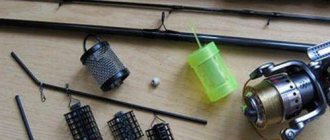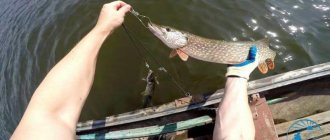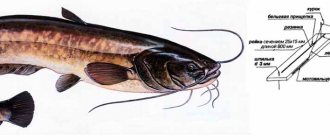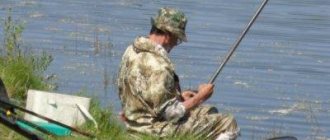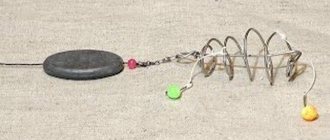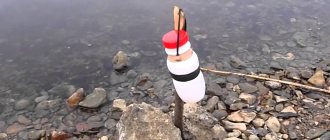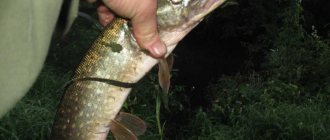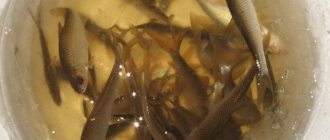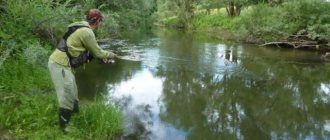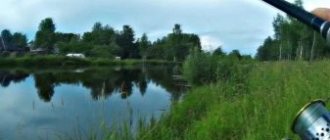What is donka and bottom fishing? How to make a donka. Sinker for donkey. Bite alarm. Tips and nuances of donk fishing. Methods for equipping a donkey. Donka with a float.
Greetings, dear fishermen, on the pages of the FishX.org website! Today I would like to talk about the topic of donkey and bottom fishing. Naturally, I will not be able to cover all its possible varieties and methods of fishing within the framework of this article. I also won’t claim that I have completely mastered all the methods of donka fishing (its various types and modifications), but I still have some experience. In this article, I will only tell you how to make the simplest and most common bottom fishing rod, I will present the knowledge I have accumulated about fishing with bottom gear and its modifications, I will give a couple of interesting tips, in general, everything that I myself successfully use.
So, let's begin …
How to make donka
I'll start by telling you how to make donka at home, rather than buying it in stores.
Donka is perhaps one of the most popular fishing gear. Therefore, to begin with, I decided to talk about the simplest version of donkey. A simple donka does not mean at all that few people can be caught with it; a lot can be caught with such tackle. Therefore, remember, pack and go fishing.
What is needed for donka
To do this, we will need a main fishing line 0.4 mm thick, also a fishing line for leashes 0.2-0.3 mm, 5 carp hooks, an olive sinker of 50-70 grams, one fishing carabiner.
How to assemble a donk
So, let's start assembling a simple donkey. To begin, we will tie leashes from fishing line 7-10 cm long to the hooks. All leashes must be tied to the hooks with a Figure Eight knot. Next, we take the main fishing line and tie an “olive” weight to it at the end, also using a figure eight knot. We retreat along the fishing line 30-35cm and knit the first leash with a hook. We retreat another 10cm along the line and tie the next hook. And so does everyone else. After all the hooks are tied, we retreat another 15 cm and tie our carabiner with the same knot. It looks something like this:
All! Donka is ready! We fasten it with a carabiner to the fishing line on the fishing rod, it can be on a reel or a slingshot, it doesn’t matter, you can even tie it to a tree. You attach the bait, cast and catch.
How to assemble bottom tackle with your own hands
Donka, “zakidushka” or elastic band is a simple device for catching fish, consisting of a weight, fishing line, rubber shock absorber, reel and leashes with hooks. The use of bottom gear for fishing for bream is one of the most effective and productive techniques that allows you to get a decent catch. Today you can buy tackle at any fishing market, but experienced fishermen prefer to make the donka with their own hands, “for themselves.”
We advise you to learn how to cook millet to feed bream when fishing on a feeder.
Rod
Bottom tackle for bream is equipped with several basic elements, among which one of the main ones is the rod. The main requirements for the device are its length, on which the distance of casting the bait will depend, and the test - the ability of the blank to act with different weights. For bottom fishing, experts advise using rods with feeders that have the required length, excellent flexibility, and the ability to cast long distances up to 150 m.
In addition, the choice of fishing rod will depend on the size of the reservoir. For long distance casting, using long rods is an excellent option. The “golden mean” is considered to be gear with a length of 3500 cm and a test weight of 40–80 g. The most unsuccessful option for bottom fishing are telescopic fishing rods, characterized by poor flexibility, the inability to change sensitivity, and a limited range of up to 60 m. The only advantage of such gear compared to feeder is its low cost.
We recommend reading about the features of fishing for carp.
Coil
There are no special requirements for the reel, since the main time of the fishing process will be spent waiting for a bite, and not spent on numerous casts of the tackle. You can use almost any, even budget, inertia-free version of the reel. The main thing is that the described device reels in the fishing line efficiently and does not provide resistance during its free descent at the moment of casting.
If you plan to use the gear for a long time and your financial capabilities allow it, experts advise choosing a high-quality reel made from durable, wear-resistant materials, which will subsequently allow you to catch not only bream and crucian carp, but also roach and silver bream.
fishing line
In the process of rigging a donkey, many novice fishermen have a choice between fishing line or braided cord. To clarify this issue, it is worth exploring what the main differences between them are. The fishing line is a classic nylon thread, which is characterized by a certain stretchability and thickness. Of course, the thicker the line, the heavier the weight it can support. For catching bream, it is recommended to use a thickness of 0.25–0.4 mm, but the final choice will depend on fishing conditions, the depth of the reservoir and the speed of the current. If the current is slow, the line should be thick.
Did you know? The world record holder for casting a rod was the German fisherman Walter Kimmerow, who managed to cast a tackle weighing 30 g over a distance of 176 m.
As for braided cord, it costs more than fishing line, but is more convenient to use. Braid has no “memory”, is not prone to stretching, is convenient for casting, and greatly simplifies hooking prey. The optimal solution for catching even the most nimble and hefty bream is a cord with a thickness of 0.2–0.28 mm.
Hooks
To catch bream, it is recommended to equip the donk with hooks that meet the following requirements:
- sharpness and the ability not to become dull over a long period;
- thickness and dimensions. The smaller the bait, the smaller and thinner the hook should be.
Pay attention to the description of the ruff fish.
The main principle of selecting hooks is to find one that will best suit the approximate size of the prey. A very small hook can attract only small fish, while a large and thick hook can scare away the bream. It is best to have several types of hooks in your arsenal and use different ones, depending on the situation.
Sinker for donkey
Continuing the topic of assembling the donkey, I would like to express my opinion as to which sinkers are preferable to use in the middle reaches, provided that the river bottom is not uniform, but has stones and irregularities. Of course, I am clearly and clearly aware that my notes in no way claim to be absolutely right, accurate and correct, but for about 4 years now I have been fishing using this method and achieving quite good results in comparison with my colleagues who fish in the usual way. It is enough to go to any fishing store, where you will be competently advised on the method of setting up any bottom gear and the method of selecting gear. It’s no secret that the final result when fishing from the bottom is influenced by everything: bait, the size and shape of the hooks, the length of the leader and the diameter of the fishing line, both main and leader. It is important to understand that even the rod itself and the method of fixing the bite play an important role.
A separate topic is sinkers, which can be of different shapes, perform the function of a feeder and many other functions. But I noticed that in moderate currents the weight of the load can be reduced somewhat without damaging the gear. But if this is done by simply replacing the sinker, then such a load will simply be carried away by the current, it will roll along the bottom, even if the latter has irregularities and protrusions. In this case, you will have to return to a heavier sinker and be content with what you have. Accordingly, at one time I thought that it was necessary to give the sinker properties so that it could, as it were, cling to the protrusions of the bottom and lie on it.
So, if you use a sinker attached to the bottom tackle at the end of the fishing line, and hooks are located above, if you know that there are stones at the bottom, the bottom is sandy or has frequent protrusions, then instead of a heavier load you can put a lighter weight, but round in shape with "donut hole" This hole will act as a retainer, and a fairly reliable one at that; the sinker will not be carried away by the flow of the current, since the area of contact of the water with the surface of the load is smaller. Thus, I managed to reduce the weight of the sinker from 50 grams to 35, which, you will agree, is significant. It seems to me that this will be useful for many fishermen.
Cone sinker of the side bottom
You can see the rigging of a side bottom with a cone-shaped sinker and a long leash tied above the load of the tackle in the picture.
And, paradoxical as it may sound, it is more promising to fish with such gear from the side of a floating craft on a small river, both during periods when the fish are hungry and during the worst bite, if you activate the nozzle.
The fact is that the rigging of an onboard bottom rod with a conical sinker and a leash tied 10 centimeters higher allows you to set the bait to a game that attracts the attention of fish, either only by oscillations of the nod spring, or by periodically driving in the sinker of the onboard bottom fishing rod along the course of a small river, followed by pulling the rigging of the bottom rod to the side boats.
A cone-shaped sinker tied to the end of the main fishing line of the side bottom rig practically does not roll on hard (sandy) bottom soil. In silted areas of small rivers, the lead bottom weight, of course, also sinks in the silt, but a highly tied leash with a nozzle will in any case be above the level of the bottom of the small river.
In addition, a leash of considerable length with a hook attached to it is connected to the bottom cone sinker of the side bottom through a stretch of the main fishing line, which allows the equipment of the bottom fishing rod as a whole to be sensitive to the most cautious fish bites.
Bite alarm, bell or whip
Some anglers are wondering what is best to use as a bite indicator when fishing with a regular donka (feeder).
If we omit some sophisticated electronic devices, then we can safely voice two main methods: using a bell or a pendulum (which bends the fishing line with its weight, and by raising or lowering these parts the fisherman decides to hook), and without any special suspended parts, only along the tip (first knee, thin whip) of the rod.
In principle, both methods have worked well, and I personally know adherents of one or the other. But it also has its own characteristics. So, in my opinion, with the help of a bell or other suspended element, it is easier to track the bite. This is especially true when the fish bite is sluggish, without sudden jerks, and there is wind outside. So, once I caught a crucian carp that was slowly lowering the pendulum, but it was problematic to track the bite with a whip. Of course, many may argue that today you can buy donkey whips of various thicknesses, that you can buy special feeder rods... But is it worth it when you fish for donkey once a month, or even twice?
It’s a difficult question, everyone decides for themselves, but I decided to use an ordinary bell. In addition, I have two thin whips in my supply, which I also use, having first tied them to the main rod.
Current bite alarm
Again, all the advantages of gear with a bell come to naught if fishing is in the current. The line is simply stretched and fishing with a bell or some other weight is not convenient, although, with some desire, it is possible. In this situation, the benefits of the whip are fully revealed. As I already said, you can buy a special feeder rod, which comes with several whips of different thicknesses and lengths, however, you will have to pay a little for everything good. I didn’t buy such a rod, but purchased the whips separately, and if necessary, I attach them to the fishing rod - everything works perfectly, the bite is visible, although the tackle itself does not look very aesthetically pleasing.
Naturally, I’m not talking about how to secure the whips, how to install the bell (and there are a lot of mounting options) - that’s a separate conversation. The main thing is that you have an understanding that you need to master both methods of fishing, since you never know where you will have to fish next time.
On rivers, I take my spinning rod, which I use to fish for pike, and depending on the strength of the current, I attach a whip of the required stiffness to it (or I fish without it at all). Once on the Volga I fished without an additional whip at all, since the current bent the spinning rod so much that the fishing rod clearly responded to the bite of even a small roach (note that the sinker was set at 40-50 grams).
Bite alarm in calm water
For fishing on lakes where there is no current, I am used to using a regular bottom with 1-2 hooks, sometimes I put a feeder, sometimes I tie a rubber shock absorber (elastic fishing), but I always use a bell as a signaling device. I place my chair to the left of the throw, so that my right hand is always literally above the working line, making it convenient to hook (for left-handed people, the opposite is true).
As you can see, both methods are good, you need to master them, and there is no better one among them. It is important to understand this so as not to get into trouble when talking in a fishing store or among your colleagues. As they say, for each place there is its own gear.
Tips and nuances of donk fishing
I often have to fish with donka (bottom tackle). Often it’s an ordinary donkey, the assembly process of which I described a little higher, sometimes I mount it on a peg, sometimes it’s a feeder tackle. In general, if you look at the literature, you can find a lot of interesting things about bottom gear, and there are true specialists who fish only with this gear.
Therefore, I will try to give some advice to a “successful donkey”, and to be more precise, I will try to voice those nuances, by observing which, you can somewhat improve your performance from using this tackle. As I said above, I will not talk about the intricacies of installation of all variations of gear, since this is a very extensive material. Here I will give some fairly universal points and some tricks that can be successfully adapted to any donka.
Enough ranting, let's move on to the tips:
- Always use leashes
- Different fishing spots require different weights
- Installation of the feeder (on a lead leash or on the main line)
- Sometimes you can catch without a feeder
- The feed should not be too viscous
- The color of the bait should match the bottom
- Proven baits: worm, bloodworm, maggot
- You need to have several baits and baits with you.
- Stock of fishing line on the reel (to cast to the right place)
- Prepare leashes with hooks in advance
- On muddy and rocky bottoms - hooks with foam
- It is advisable to place more than one hook (the first one is closer to the bottom, the second one is slightly higher)
- It is necessary to fish all areas of the reservoir (near the shore, medium depths, depth)
- Prepare your fishing spot in advance, especially if casting by hand
- Mix and match baits and baits, sandwiches sometimes produce good results.
- If there’s no bite, don’t rush to pull out the tackle and make a new cast - you can reel in the bottom a little and let it sit for another minute
- Movement provokes fish to bite
- In the current, the tackle can be coarser, because the fish attacks there more actively.
- I put leashes at least 20 cm long.
- I prefer to use donkey hooks with a long shank and a tip bent to the side.
- If it is possible to fish without a feeder (for example, bait can be thrown by hand), I fish without a feeder, and the tackle becomes less noisy and noticeable.
- I always add various flavors to my bait - this allows me to attract fish without overfeeding them.
- Use beads to absorb the impact of the weight or feeder on the knots of the cord or fishing line (for a sliding type of installation).
- If conditions and fishing techniques allow, I refuse swivels and other metal parts of the equipment.
Here, in principle, are all the main tips and my experiences regarding donk fishing.
How to fish with donka
Bottom fishing can be done in several ways. The main thing is that the bottom of the reservoir and its water area allow casting and installation of the rig.
Important! Intensive overgrowth of the water area, cramps, large stones and artificial waste objects at the bottom of the reservoir can hinder fishing.
Otherwise, catching a predator on a donk, like all peaceful fish, is similar in its technology, the main ones of which we will consider in the continuation of the material.
Bottom tackle with shock absorber
The use of bottoms with rubber shock absorbers is convenient in large open water areas and allows you to silently cast bait, which gives you the opportunity to catch particularly cautious and shy fish. The tackle does not require a rod. The load is thrown manually or delivered to the installation site by boat. A model is tied to the load, with which the main cord is connected, with hooks and bait. The stretchability of the model allows you to rewind and reinstall the cord on the fishing trajectory without casting the sinker.
Bottom fishing rod
Most often, the rod used is a spinning rod with certain performance characteristics that satisfy fishing conditions. An inertia-free reel is used as a reel and device for effectively casting equipment, winding up the cord and retrieving the trophy. In such installations, the sinker is attached to the fishing line without a shock absorber using a blind or sliding type.
Bottom tackle with feeder
It is more effective to fish with a donk with a feeder using a special feeder rod. The features of the feeder allow you to fish in a narrow range, while simultaneously achieving the highest efficiency in attaching fish to a promising point, controlling the bite, hooking and landing the trophy. Feeder technology is an improved method of catch fishing. And also higher demands are placed on reels, which must have a friction clutch and a baitrunner adjustable in several stages.
The fishing itself is carried out from the shore, from a stationary installation of the rod on a stand. For the most part, the feeder specializes in fishing for carp fish, but with some modifications in the equipment it can be successfully used for hunting all types of predatory fish.
Methods for equipping a donkey
Now I will give a couple of ways to rig bottom gear:
As you can see, the basic recommendations and schemes are quite simple. But I promise you, doing them will ensure that you end up with fish (it works for me anyway). Naturally, each fisherman has his own experience and knowledge, you also need to remember about the correct installation of the donkey, and constantly experiment. Then the mood will be great. And fishing will please you with its results.
Donka with a float
Let's look at another way of rigging, this is a donk with a float. Small rivers are interesting because the fisherman needs to apply the maximum of his knowledge and skills in order to catch a really large fish. I have noticed that even in very narrow “streams” there are such specimens that you simply wonder where such fish come from. But, at the same time, as I already noted above, catching fish in small reservoirs and rivers is a difficult undertaking, since the fish in such places are quite shy and react to minimal changes in the environment, both aquatic and those within the reach of fish above the surface of the water (study the question of fish vision).
It is in such areas that summer jig tackle and a bottom with a float mounted on a telescopic rod have proven themselves to be excellent, which helps when you need to carefully approach the shore, camouflage yourself, and identify a promising place, the depth of which rarely exceeds 1-2 meters.
Scheme of a donkey with a float
A bottom fishing rod with a float is a reality. The principle of such a donkey is as follows: in essence, it is an ordinary float fishing rod; a sliding weight is used as a sinker (I use a conical sinker that is not carried away by the current). The load is secured by a bead or swivel. The most interesting thing is that the float should only protrude slightly above the surface of the water. And while many fishermen achieve this effect by raising and lowering the rod tip and simply adjusting the depth, I prefer to also load the lower antenna of the float with pellets.
Why surround the float?
It’s simple, the less resistance the fish experiences when biting (and a sliding sinker already implies that there will be resistance), the more reliable and sure the bite will be. Therefore, the float, which is additionally loaded, will become a minor obstacle for the fish, which is what the fisherman needs. Such a bottom fishing rod is also interesting because you can successfully fish without even going close to the shore, which, you see, sometimes plays a key role in fishing.
From my experience I will say that using a donkey with a float I fished both in the current and in still water. I liked fishing on the current more, because... the fish grabs the bait more greedily. The catch most often included perch and roach. A couple of times I had to pull out bream too. So, try it, master this bottom fishing rod, and don’t forget about the many other variations of bottom fishing rods with a float.
In principle, I think we can stop here for now and draw some conclusions regarding donkey. Which? Decide for yourself.
I perceive the donka as a very diverse tackle, the variations of which are simply masses. Donk fishing is an experiment where you can always change and improve something. Use a float, a feeder, experiment with leashes, hook placement, bait, play with depth, use a variety of rigging methods and much more. So study and go fishing.
All the best to you and successful bottom fishing!
